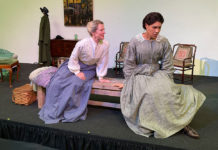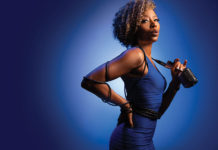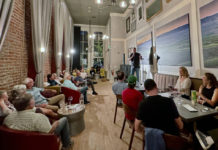It’s time to plant!
The California Native Plant Society’s sale is coming! It’s on October 13, from 9 a.m. to 1 p.m. at the Vet’s Memorial Building and parking lot. Get there early! They sell bulbs, perennials, trees, books, posters, seeds, shrubs and more.
October is the start of our planting season and many nurseries and garden shops will be featuring our beautiful natives.
The best time of year can be the busiest. New plants to put in, mulch to spread thickly over the soil, and other “chores” are upon us. I can’t really call them chores, as they are so much fun. As for mulch, Phil Van Soelen of CalFlora reminds us to leave some open areas of soil unmulched for the native bees to use. Bumblebees and other native bees dig holes to over-winter in and for nesting.
As for cleaning up, raking, trimming, please leave lots of debris in your garden over the winter. Insects, and especially spiders, use the dead twigs, stems, leaves and other debris to lay their eggs, to protect themselves from predators, and to stay hidden and cozy. Birds will scratch in the area and find a haven of habitat.
By the spring warm-up, most of the eggs will have hatched and insects have moved on to complete their life cycle. If there is remaining debris, it can then be composted.
Now let’s plant:
Using a small circumference sprinkler, soak down the area where you’ll be planting the natives and other plants. A shovel leaves the sides of the hole slick, so rough them up a bit with a hand cultivator. The moist, rough sides will encourage the roots to spread sideways, not just down. Robert Kourik’s fascinating new book, “Roots Demystified…change your gardening habits to help roots thrive” (Metamorphic Press) has multiple drawings of the root spread of many shrubs, trees and perennials. He gives you an idea of the extent of the area that should be watered and mulched. This book also tells of a fairly revolutionary way of planting on mounds, rather than at soil level. I haven’t yet read enough of it to understand his method, but he certainly swears by it. He is from Occidental; I heard him speak at the Heritage Festival; his book is pretty interesting.
At any rate, I water the potted plant thoroughly and before placing it in the hole, open up the root ball so the roots are no longer in a tight ball. Plant slightly above soil level, as plants will sink after being watered. Gently pack the soil around the plant and water again. Mulch the surface with a couple of inches of organic mulch, such as rice straw or dead leaves, but keep the mulch several inches away from the main stem. If mulch touches the stem, it may cause the stem to rot. Keep the area watered until the rains come.
A common mistake in putting a new garden area together is one many gardeners and I have made: planting water lovers and drought tolerant plants together…only to kill one or the other! Keep the thirstier plants near your water system, most likely near the house and the vegetable garden. Put your perennial shrubs, such as salvias, further away where they can have an occasional drink. I have berms in my cottage garden along one edge. In it I grow ‘Hot Lips’ salvia, red monkey flowers, sedum ‘Autumn Joy’ and buckwheats. They overlook the wetter flat bed of annuals.
My cottage garden is thriving, even as autumn is closing in, and it’s full of annuals going to seed. Next season I will plant a larger area full of annual cosmos and orange cosmos. They are ever-blooming and the little birds are always busy gleaning seeds, as well as bees and pollinators going for nectar. Flat-topped zinnias add to the excitement, as do the asters and golden rod.
“Beyond Foraging: Discovering the Real California Cuisine” is the title of Judith Larner Lowry’s talk for the CNPS meeting on October 16. Judith wrote two of my favorite books: “The Landscaping Ideas of Jays” and “Gardening with a Wild Heart.” I can only assume that her talk will be unusual and unique, as she has been studying backyard habitat restoration for years. She lives in Bolinas and her web site www.larnerseeds.com will give all the information you need to visit or contact her.
Meetings are held at 7:30 p.m. at the Luther Burbank Art & Garden Center at 2050 Yulupa Avenue in Santa Rosa. Please call Leia at 322-6722 if you need more information.
Please write me at: [email protected].
64.8
F
Healdsburg
April 3, 2025







